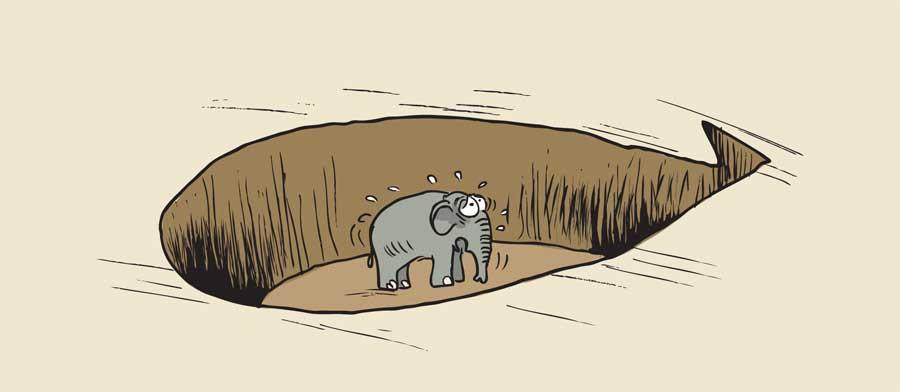08 Jul 2024 - {{hitsCtrl.values.hits}}

Sri Lanka witnessed the passing of another iconic elephant, fondly known as ‘Chandi’ on the banks of Kaduru Wewa, Galgamuwa on Friday. Villagers gathered to mourn the death of this rather mischievous yet friendly elephant who had been a frequent visitor to many households in the area. Galgamuwa is a village that has been at the receiving end of the human-elephant conflict over the past few years. Even though these remote areas have been elephant habitats, rapid urbanisation has compelled elephants to not only change their migratory routes but walk for long distances in search of fodder.
Chandi flaunted one tusk, as a result of a fight and this tusker met its untimely death as a result of a fight with another tusker in the area. But on the contrary, Sri Lanka is currently witnessing a spike in elephant deaths due to unnatural causes such as illegal electrocution, elephants being killed by poachers and farmers who posses illegal weapons such as shotguns and muzzleloaders, snaring and various other causes. Even though villagers gathered to mourn this tusker’s death, elephants are now considered a pest in many other areas in the country.
Various encroachment attempts have been made by politicians and those in power, thereby posing a threat to elephants and other wildlife in remote areas in the country. Back in the day, areas such as Habarana, Polonnaruwa, Anuradhapura, Galgamuwa had a high density of elephants who roamed around in the jungles, walked to nearby tanks and reservoirs to feed on fresh grass, then walked back to their resting places and in fact there was a balance in these ecosystems that helped their survival. Today, due to habitat fragmentation and deforestation, these gentle giants have lost their habitats.
Areas that once had green forest patches have now been cleared to put up houses, hotels and other constructions. Even though some of these establishments carry the ‘eco-friendly’ label, many of them have been constructed by disturbing elephant crossings, other state forests and similar ecosystems with a rich biodiversity. While many harp on wildlife tourism in Sri Lanka, it doesn’t necessarily mean that one has to put up a hotel on an elephant crossing to catch a glimpse of a herd of elephants! There are sustainable approaches in which tourists could watch elephants rather than clearing their only migratory route.
Apart from their visual appearance, elephants are said to be great ecosystem engineers, bringing about the right balance in the ecosystem. Everything from their feeding patterns to behaviours, reproductive cycles do some service to nature. But their ecosystem services are seldom appreciated.
However, the damage done is irreversible. What could now be seen is a spike in attempts, mostly illegal, to encroach into National Parks and other protected areas despite their legal status. A classic example is a proposal by one minister to open a bus route via Wilpattu National Park despite having a Supreme Court order against developing the said route. Wilpattu has been subject to rapid deforestation since 2009, due to vested political interests.
Environmentalists have always argued that they have never said no to development. Indeed, a country needs to develop but that doesn’t mean that its last remaining forest patches need to be sacrificed for concrete jungles. Development doesn’t only mean infrastructure. It comes with a change in attitudes and mindsets. It comes with proper studies on pros and cons, Environmental Impact Assessments and analysing other technicalities that would bring about sustainable development.
At this rate, Sri Lanka is likely to lose all its gentle giants, facing a similar plight as the Woolly Mammoth if nothing is going to be done about bringing the right balance between humans and the environment.
24 Nov 2024 3 hours ago
24 Nov 2024 5 hours ago
24 Nov 2024 6 hours ago
24 Nov 2024 7 hours ago